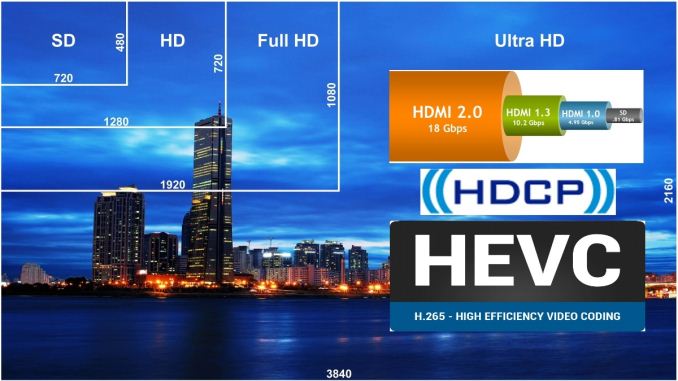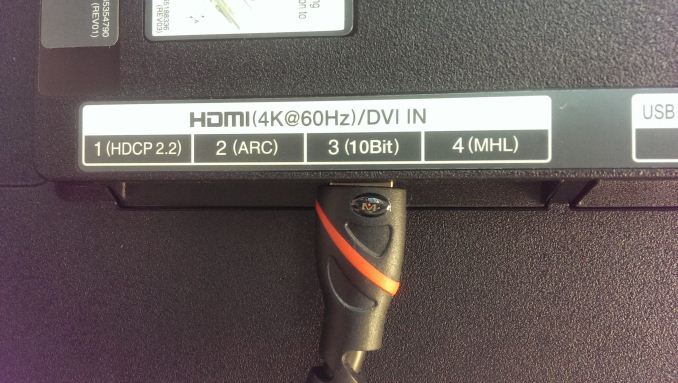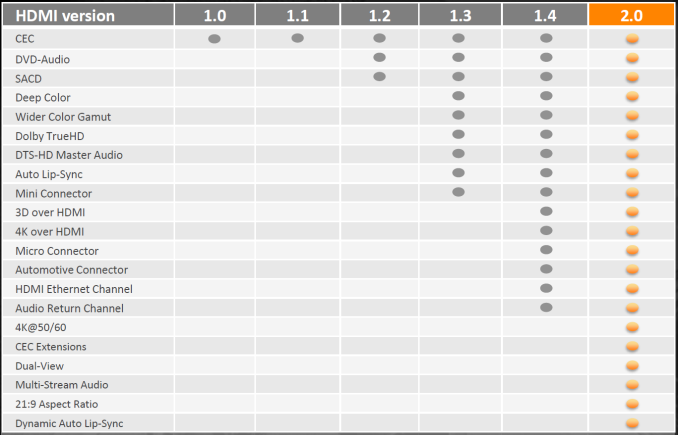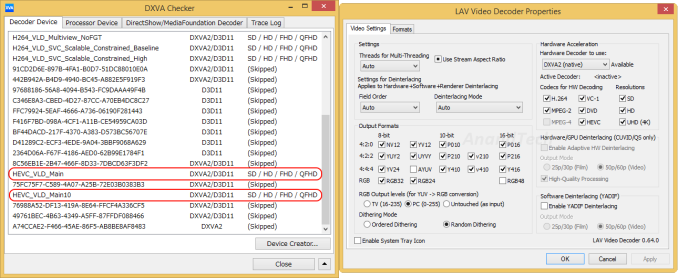Future-proofing HTPCs for the 4K Era: HDMI, HDCP and HEVC
by Ganesh T S on April 10, 2015 6:30 AM EST
4K (Ultra High Definition / UHD) has matured far more rapidly compared to the transition from standard definition to HD (720p) / FHD (1080p). This can be attributed to the rise in popularity of displays with high pixel density as well as support for recording 4K media in smartphones and action cameras on the consumer side. However, movies and broadcast media continue to be the drivers for 4K televisions. Cinemal 4K is 4096x2304, while true 4K is 4096x2160. Ultra HD / UHD / QFHD all refer to a resolution of 3840x2160. Despite the differences, '4K' has become entrenched in the minds of the consumers as a reference to UHD. Hence, we will be using them interchangeably in the rest of this piece.
Currently, most TV manufacturers promote UHD TVs by offering an inbuilt 4K-capable Netflix app to supply 'premium' UHD content. The industry believes it is necessary to protect such content from unauthorized access in the playback process. In addition, pushing 4K content via the web makes it important to use a modern video codec to push down the bandwidth requirements. Given these aspects, what do consumers need to keep in mind while upgrading their HTPC equipment for the 4K era?
Display Link and Content Protection
DisplayPort outputs on PCs and GPUs have been 4K-capable for more than a couple of generations now, but televisions have only used HDMI. In the case of the SD to HD / FHD transition, HDMI 1.3 (arguably, the first HDMI version to gain widespread acceptance) was able to carry 1080p60 signals with 24-bit sRGB or YCbCr. However, from the display link perspective, the transition to 4K has been quite confusing.
4K output over HDMI began to appear on PCs with the AMD Radeon 7000 / NVIDIA 600 GPUs and the Intel Haswell platforms. These were compatible with HDMI 1.4 - capable of carrying 4Kp24 signals at 24 bpp (bits per pixel) without any chroma sub-sampling. Explaining chroma sub-sampling is beyond the scope of this article, but readers can think of it as a way of cutting down video information that the human eye is less sensitive to.
HDMI 2.0a
HDMI 2.0, which was released in late 2013, brought in support for 4Kp60 video. However, the standard allowed for transmitting the video with chroma downsampled (i.e, 4:2:0 instead of the 4:4:4 24 bpp RGB / YCbCr mandated in the earlier HDMI versions). The result was that even non-HDMI 2.0 cards were able to drive 4Kp60 video. Given that 4:2:0 might not necessarily be supported by HDMI 1.4 display sinks, it is not guaranteed that all 4K TVs are compatible with that format.
True 4Kp60 support comes with HDMI 2.0, but the number of products with HDMI 2.0 sources can be counted with a single hand right now. A few NVIDIA GPUs based on the second-generation Maxwell family (GM206 and GM204) come with HDMI 2.0 ports.
On the sink side, we have seen models from many vendors claiming HDMI 2.0 support. Some come with just one or two HDMI 2.0 ports, with the rest being HDMI 1.4. In other cases where all ports are HDMI 2.0, each of them support only a subset of the optional features. For example, not all ports might support ARC (audio return channel) or the content protection schemes necessary for playing 'premium' 4K content from an external source.

HDMI Inputs Panel in a HDMI 2.0 Television (2014 Model)
HDMI 1.3 and later versions brought in support for 10-, 12- and even 16b pixel components (i.e, deep color, with 30-bit, 36-bit and 48-bit xvYCC, sRGB, or YCbCr, compared to 24-bit sRGB or YCbCr in previous HDMI versions). Higher bit-depths are useful for professional photo and video editing applications, but they never really mattered in the 1080p era for the average consumer. Things are going to be different with 4K, as we will see further down in this piece. Again, even though HDMI 2.0 does support 10b pixel components for 4Kp60 signals, it is not mandatory. Not all 4Kp60-capable HDMI ports on a television might be compatible with sources that output such 4Kp60 content.
HDMI 2.0a was ratified yesterday, and brings in support for high dynamic range (HDR). UHD Blu-ray is expected to have support for 4Kp60 videos, 10-bit encodes, HDR and BT.2020 color gamut. Hence, it has become necessary to ensure that the HDMI link is able to support all these aspects - a prime reason for adding HDR capabilities to the HDMI 2.0 specifications. Fortunately, these static EDID extensions for HDR support can be added via firmware updates - no new hardware might be necessary for consumers with HDMI 2.0 equipment already in place.
HDCP 2.2
High-bandwidth Digital Content Protection (HDCP) has been used (most commonly, over HDMI links) to protect the path between the player and display from unauthorized access. Unfortunately, the version of HDCP used to protect HD content was compromised quite some time back. Content owners decided that 4K content would require an updated protection mechanism, and this prompted the creation of HDCP 2.2. This requires updated hardware support, and things are made quite messy for consumers since HDMI 2.0 sources and sinks (commonly associated with 4K) are not required to support HDCP 2.2. Early 4K adopters (even those with HDMI 2.0 capabilities) will probably need to upgrade their hardware again, as HDCP 2.2 can't be enabled via firmware updates.
UHD Netflix-capable smart TVs don't need to worry about HDCP 2.2 for playback of 4K Netflix titles. Consumers just need to remember that whenever 'premium' 4K content travels across a HDMI link, both the source and sink must support HDCP 2.2. Otherwise, the source will automatically downgrade the transmission to 1080p (assuming that an earlier HDCP version is available on the sink side). If an AV receiver is present in the display chain, it needs to support HDCP 2.2 also.
Key Takeaway: Consumers need to remember that not all HDMI 2.0 implementations are equal. The following checklist should be useful while researching GPU / motherboard / AVR / TV / projector purchases.
- HDMI 2.0a
- HDCP 2.2
- 4Kp60 4:2:0 at all component resolutions
- 4Kp60 4:2:2 at 12b and 4:4:4 at 8b component resolutions
- Audio Return Channel (ARC)
HDMI 2.0 has plenty of other awesome features (such as 32 audio channels), but the above are the key aspects that, in our opinion, will affect the experience of the average consumer.
HEVC - The Video Codec for the 4K Era
The move from SD to HD / FHD brought along worries about bandwidth required to store files / deliver content. H.264 evolved as the video codec of choice to replace MPEG-2. That said, even now, we see cable providers and some Blu-rays using MPEG-2 for HD content. In a similar manner, the transition from FHD to 4K has been facilitated by the next-generation video codec, H.265 (more commonly known as HEVC - High-Efficiency Video Coding). Just as MPEG-2 continues to be used for HD, we will see a lot of 4K content being created and delivered using H.264. However, for future-proofing purposes, the playback component in a HTPC setup definitely needs to be capable of supporting HEVC decode.
Despite having multiple profiles, almost all consumer content encoded in H.264 initially was compliant with the official Blu-ray specifications (L4.1). However, as H.264 (and the popular open-source x264 encoder implementation) matured and action cameras began to make 1080p60 content more common, existing hardware decoders had their deficiencies exposed. 10-bit encodes also began to gain popularity in the anime space. Such encoding aspects are not supported for hardware accelerated decode even now. Carrying forward such a scenario with HEVC (where the decoding engine has to deal with four times the number of pixels at similar frame rates) would be quite frustrating for users. Thankfully, HEVC decoding profiles have been formulated to avoid this type of situation. The first two to be ratified (Main and Main10 4:2:0 - self-explanatory) encompass a variety of resolutions and bit-rates important for the consumer video distribution (both physical and OTT) market. Recently ratified profiles have range extensions [ PDF ] that target other markets such as video editing and professional camera capture. For consumer HTPC purposes, support for Main and Main10 4:2:0 will be more than enough.
HEVC in HTPCs
Given the absence of a Blu-ray standard for HEVC right now, support for decoding has been tackled via a hybrid approach. Both Intel and NVIDIA have working hybrid HEVC decoders in the field right now. These solutions accelerate some aspects of the decoding process using the GPU. However, in the case where the internal pipeline supports only 8b pixel components, 10b encodes are not supported for hybrid decode. The following table summarizes the current state of HEVC decoding in various HTPC platforms. Configurations not explicitly listed in the table below will need to resort to pure software decoding.
| HEVC Decode Acceleration Support in Contemporary HTPC Platforms | ||
| Platform | HEVC Main (8b) | HEVC Main10 4:2:0 (10b) |
| Intel HD Graphics 4400 / 4600 / 5000 | Hybrid | Not Available |
| Intel Iris Graphics 5100 | Hybrid | Not Available |
| Intel Iris Pro Graphics 5200 | Hybrid | Not Available |
| Intel HD Graphics 5300 (Core M) | Not Available | Not Available |
| Intel HD Graphics 5500 / 6000 | Hybrid | Hybrid |
| Intel Iris Graphics 6100 | Hybrid | Hybrid |
| NVIDIA Kepler GK104 / GK106 / GK107 / GK208 | Hybrid | Not Available |
| NVIDIA Maxwell GM107 / GM108 / GM200 / GM204 | Hybrid | Not Available |
| NVIDIA Maxwell GM206 (GTX 960) | Hardware | Hardware |
Note that the above table only lists the vendor claims, as exposed in the drivers. The matter of software to take advantage of these features is a completely different aspect. LAV Filters (integrated in the recent versions of MPC-HC and also available as a standalone DirectShow filter set) is one of the cutting-edge softwares taking advantage of these driver features. It is a bit difficult for the casual reader to get an idea of the current status from all the posts in the linked thread. The summary is that driver support for HEVC decoding exists, but is not very reliable (often breaking with updates).
HEVC Decoding in Practice - An Example
LAV Filters 0.64 was taken out for a test drive using the Intel NUC5i7RYH (with Iris Graphics 6100). As per Intel's claims, we have hybrid acceleration for both HEVC Main and Main10 4:2:0 profiles. This is also brought out in the DXVAChecker Decoder Devices list.
A few sample test files (4Kp24 8b, 4Kp30 10b, 4Kp60 8b and 4Kp60 10b) were played back using MPC-HC x64 and the 64-bit version of LAV Video Decoder. The gallery below shows our findings.
In general, we found the hybrid acceleration to be fine for 4Kp24 8b encodes. 4Kp60 streams, when subject to DXVAChecker's Decoder benchmark, came in around 45 - 55 fps, while the Playback benchmark at native size pulled that down to the 25 - 35 fps mark. 10b encodes, despite being supported in the drivers, played back with a black screen (indicating either the driver being at fault, or LAV Filters needing some updates for Intel GPUs).
In summary, our experiments suggest that 4Kp60 HEVC decoding with hybrid acceleration might not be a great idea for Intel GPUs at least. However, movies should be fine given that they are almost always at 24 fps. That said, it would be best if consumers allow software / drivers to mature and wait for full hardware acceleration to become available in low-power HTPC platforms.
Key Takeaway: Ensure that any playback component you add to your home theater setup has hardware acceleration for decoding
(a) 4Kp60 HEVC Main profile
(b) 4Kp60 HEVC Main10 4:2:0 profile
Final Words
Unless one is interested in frequently updating components, it would be prudent to keep the two highlighted takeaways in mind while building a future-proof 4K home theater. Obviously, 'future-proof' is a dangerous term, particularly where technology is involved. There is already talk of 8K broadcast content. However, it is likely that 4K / HDMI 2.0 / HEVC will remain the key market drivers over the next 5 - 7 years.
Consumers hoping to find a set of components satisfying all the key criteria above right now will need to exercise patience. On the TV and AVR side, we still don't have models supporting HDMI 2.0a as well as HDCP 2.2 specifications on all their HDMI ports. On the playback side, there is no low-power GPU sporting a HDMI 2.0a output while also having full hardware acceleration for decoding of the important HEVC profiles.
In our HTPC reviews, we do not plan to extensively benchmark HEVC decoding until we are able to create a setup fulfilling the key criteria above. We will be adopting a wait and watch approach while the 4K HTPC ecosystem stabilizes. Our advice to consumers will be to do the same.















93 Comments
View All Comments
10042015 - Friday, April 10, 2015 - link
This is exactly right, to further quote Wikipedia:>> >>
UHD
UHD is a resolution of 3840 pixels × 2160 lines (8.3 megapixels, aspect ratio 16:9) and is one of the two resolutions of ultra high definition television targeted towards consumer television, the other being FUHD which is 7680 pixels × 4320 lines (33.2 megapixels). UHD has twice the horizontal and vertical resolution of the 1080p HDTV format, with four times as many pixels overall.[1][31]
Digital cinema
The Digital Cinema Initiatives consortium established a standard resolution of 4096 pixels × 2160 lines (8.8 megapixels, aspect ratio 256:135) for 4K film projection. This is the native resolution for DCI-compliant 4K digital projectors and monitors; pixels are cropped from the top or sides depending on the aspect ratio of the content being projected. The DCI 4K standard has twice the horizontal and vertical resolution of DCI 2K, with four times as many pixels overall. DCI 4K does not conform to the standard 1080p Full HD aspect ratio (16:9), so it is not a multiple of the 1080p display.
4K digital films may be produced, scanned, or stored in a number of other resolutions depending on what storage aspect ratio is used.[33][34] In the digital film production chain, a resolution of 4096 × 3112 is often used for acquiring "open gate" or anamorphic input material, a resolution based on the historical resolution of scanned Super 35mm film.[35]
Format Resolution Display aspect ratio Pixels
UHDTV 3840 × 2160 1.78:1 (16:9) 8,294,400
Ultra wide television 5120 × 2160 2.33:1 (21:9) 11,059,200
WHXGA 5120 × 3200 1.60:1 (16:10) 16,384,000
DCI 4K (native resolution) 4096 × 2160 1.90:1 (256:135) 8,847,360
DCI 4K (CinemaScope cropped) 4096 × 1716 2.39:1 7,028,736
DCI 4K (flat cropped) 3996 × 2160 1.85:1 8,631,360
<< <<
Source:
https://en.wikipedia.org/wiki/4K_resolution
nathanddrews - Friday, April 10, 2015 - link
The Consumer Electronics Association would disagree with you. They defined 4K and UHD as being the same thing. UHD/4K qualifies for any television capable of displaying a MINIMUM of 3840x2160."The group also defined the core characteristics of Ultra High-Definition TVs, monitors and projectors for the home. Minimum performance attributes include display resolution of at least eight million active pixels, with at least 3,840 horizontally and at least 2,160 vertically. Displays will have an aspect ratio with width to height of at least 16 X 9. To use the Ultra HD label, display products will require at least one digital input capable of carrying and presenting native 4K format video from this input at full 3,840 X 2,160 resolution without relying solely on up-converting."
https://www.ce.org/News/News-Releases/Press-Releas...
geekfool - Friday, April 10, 2015 - link
anandtech, generalizing helps no one if its base assumption is wrong as per the NHK R&D/BBC R&D multi year collaboration....you mean officially called
"UHD-1" at 3840x2160 and
"UHD-2" at 7680x4320 pixels and is ITU BT.2020 real colour 10bit/12bit per pixel 120 fps etc.... compliant
+ lets also not forget 22/2 sound capable as per the NHK R&D/BBC R&D multi year collaboration to define all this UHD-1/UHD-2 standard.
http://www.bbc.co.uk/rd/blog/2013/06/defining-the-...
and official EBU test sequences are available up to 12_EBU_ZurichAthletics2014_UHD_300p_HDR 3840x2160 360° "300 fps" 3026 52636-55635 and beyond.
https://tech.ebu.ch/docs/testmaterial/ebu_test_seq...
Samus - Friday, April 10, 2015 - link
dude, people call things out against their "standard" names all the time. whats next are you going to harp on people calling a USB flash drive a "thumb" drive?SirMaster - Friday, April 10, 2015 - link
4K is a generic term. You are referring to 4K DCI. UHD is simply another resolution in the 4K family.4K resolution, also called 4K, refers to a display device or content having horizontal resolution on the order of 4,000 pixels. Several 4K resolutions exist in the fields of digital television and digital cinematography.
Scabies - Friday, April 10, 2015 - link
Remember how "HD" came to refer to everything higher than 480p? Same idea. If it's 4K-ish, they're gonna call it 4K since that has the greatest market buzzword value right now.geekfool - Friday, April 10, 2015 - link
in the UK at least , "HD ready" was deemed acceptable for "720P" by the sale teams,not by the consumers, and "full HD" for "1080P"....as of today, i see another PR fake "UHD-1" aka 4k/UHD happening , as in they will label anything that is NOT ITU-R Rec. BT.2020 compliant as "UHD [4K] ready" and "UHD [8K] ready" while the real UHD-1/UHD-2 become Full UHD [4k/8k]...
Joint Task Force on Networked Media (JT-NM)
Minimum Viable System Requirements
Of a Sample System Architecture for Live Multi-Camera Studio Production
if these UHD (12bit!) screen is/are not ITU-R “Rec. BT.2020″ 10bit/12bit real colour compliant then why should we htpc users care....
https://tech.ebu.ch/docs/groups/jtnm/JT-NM%20MVS%2...
Video Format Resolution – The system shall be capable of carrying video payload of any
resolution up to the size of UHDTV2 (7680 x 4320).
Video Image Rate – The system shall be capable of carrying video payload of any frame or
field rate up to 300 Hz, and shall be capable of carrying NTSC style fractional frame rates at
multiples of (1000/1001).
Video Sample Depth – The system shall be capable of carrying video payload sample depths of
10 or 12 bits.
Video Chroma Sampling – The system shall be capable of carrying a video payload of 4:2:2 or
4:4:4 chroma sampling.
Alpha Channel – The system shall be capable of carrying a video payload that contains an
Alpha Channel (a component that represents transparency).
Color Spaces – The system shall be capable of carrying video payload in the color space of
ITU-R Rec. BT.601, ITU-R Rec. BT.709, and ITU-R Rec. BT.2020.
jay401 - Friday, April 10, 2015 - link
Btw, the first image in the article has a typo "efficieny" making it seem fake.aaronwt - Saturday, April 18, 2015 - link
Why are they calling 1080P "full HD"? There is no such thing. It's just a marketing term. 1080P is HD.SydneyBlue120d - Friday, April 10, 2015 - link
What about AMD and HEVC? I do not see any AMD part listed in the HEVC decoding table :)